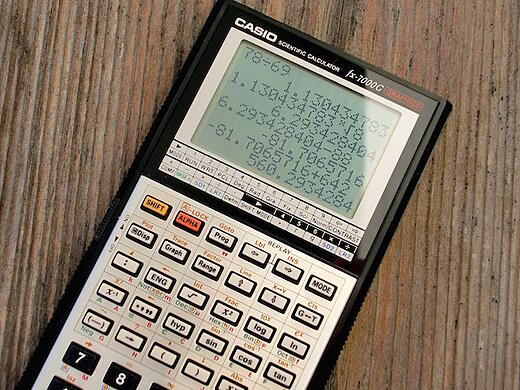Finding Inequality Solutions on Graphing Calculator
A graphing calculator is a unique tool in math and science. Graphing calculators perform the same functions as a regular calculator, and have more complex functions, like being able to calculate fractions, logarithms, and square roots. There are some big names in graphing calculators that are trusted and have been around for a long time — you may recognize the classic TI-84 from one of your math classes. Online graphing calculators are fairly new, and often free. We'll go over the best physical and online graphing calculators to help you decide which one is right for you. Graphing calculators have more powerful and complex computers than standard calculators, and are named as such because they have graphing capabilities. They can solve complex equations and plot graphs. They are also programmable, and are a useful tool if you're working on a project long term and need it to store information or solve higher level math problems. Some graphing calculators also have a CAS, or computer algebra system, meaning it can also do algebraic equations. Graphing calculators are essentially handheld computers, so it's important to get the right one for you. Graphing calculators allow you to calculate statistics, and easily convert your results into a graph. Of course, plotting graphs is a highly important part of a graphing calculator. This allows you to work on the problem itself, rather than spending time working through the math. This may seem counter-intuitive. Isn't learning the math itself the point? Yes, but even if you've mastered the skills, some equations can take a long time to work through. The graphing functions and statistics are two of the main functions you'll use as a student. You may also use them for calculus and trigonometry, in which case a CAS may help. Not all graphing calculators are equipped with a CAS. Make sure you know what you'll be using your calculator, and whether or not you'll need one with a CAS. I mentioned that graphic calculators are programmable, so they can also be used to store data in case it is needed for an equation or graph later. Some researchers use graphing calculators alongside their other equipment. They plug into computers or other machines, and gather information that can later be accessed and factored into equations. Remember, graphing calculators can solve multiple equations at once so this can help save a lot of time and work. Physical graphing calculators are a big investment, and often a really good one. If you're serious about your graphing calculator needs, and know you need a high-powered device to take with you to class, exams, or work, this mini-computer is an important part of your life. The TI-84 Plus is a traditional graphing calculator, and is a simple device on which to learn the basics of a graphing calculator. It's a great tool for middle and high school students who are beginning more advanced math studies, since the design and 10 pre-loaded apps can help you learn math skills and how to use a graphing calculator simultaneously. This calculator is approved the SAT, PSAT, ACT, IB, and AP exams. This ultra-powerful graphing calculator is great for high school and college students taking higher level math and science courses. The 3.2 inch display screen is an amazing feature for students who are taking engineering, physics, and calculus. The CAS saves and stores information, so you can edit and manipulate equations, which helps you use your time efficiently when solving complex problems. This calculator is approved for the SAT, PSAT, and AP exams. The Casio FX-9860 GII is perfect for younger students who are just learning graphing calculators and those on a budget. The extra-wide display screen and user-friendly interface make this calculator easy to navigate, though it is less powerful than some other options. It also comes with pre-loaded applications like the spreadsheet app, geometry app, and conics app, as well as the user reference guide and 200 hours of battery life. This calculator is approved for the SAT, PSAT, ACT, and AP tests. The TI-84 Plus CE is a high resolution, full-color backlit display calculator. It has a sleek design and tons of memory. It's a real upgrade in both power and user experience from other models, especially in terms of display and speed. It also comes with a rechargeable battery and is available in different colors. This calculator is approved for the SAT, PSAT, ACT, AP, and IB exams. A remarkably small and thin CAS graphing calculator, the HP Prime has a huge screen display that makes it a great pick for both students and professionals that need a high-powered tool. This calculator was modeled after smartphones, and it shows. It has a touchscreen display, geometry, spreadsheet, and advanced graphing apps, and more apps available for download. The interface looks similar to a smartphone, and has additional features like exam mode. This calculator is approved for the SAT. For those who are extra mobile, online calculators are a great resource. You can try out different calculators without any financial investment, and create an account to save your work and return to it at any time and from any device. Your preferred online graphing calculator will depend on your needs and what kind of interface you prefer. This downloadable graphing calculator is great for those who have used or learned on TI-84's, since it lists out the functions and examples as compared to the TI-84. GraphCalc also provides instructions on how to use the calculator and all of its tools, and claims that it "almost completely replaces TI83 and TI84 Plus calculators." It also has a commonly asked questions section, and offers resources to other online graphing calculators. Desmos has a long list of examples in each category that makes this graphing calculator easy to use and understand. It has a full screen experience, so you can easily see and edit your work. It has a pop-up keyboard, allowing you to type in your equations in a dialogue box on the left side and see them displayed, while simultaneously allowing you to view the graph on the right. You can also create an account and save your graphs. Mathway has a similar layout to Demos, and includes a popup keyboard, a dialogue box, and a side-by-side equation and graph view display. The different functions are in a drop-down menu, which is a super helpful way to navigate the calculator. It doesn't have examples, but it does have a chat-like tutorial feature allow that guides you as you learn the calculator and solve equations. It also features the ability to create an account. Meta calculator actually separates out the functions of a traditional "graphing calculator" into four different calculators. On the homepage, you select the graphing calculator, scientific calculator, matrix calculator, and statistics calculator. It makes it easy to use since you're not playing around and searching for different functions if you're unfamiliar with a standard graphing calculator. You can switch between calculators using the tabs on the top, and each calculator also separates functions using tabs. So for example, the graphing calculator toggles between the equations, tables, intersections, and plot points. It makes it easy to organize and keep track of your work. The Geogebra calculator has the most user-friendly system. The menu of tools and functions is laid out using handy graphics, which help you navigates quickly through the calculator, and easily find what you're looking for. The calculator function allows you to enter and view equations in a dialogue box on the left, and view the graph on the right. It also has a drop-down menu with the familiar options you'd find in most programs (save, export, etc) and you can create an account to save your work. You need to know more than just how to use a graphing calculator; you have to be able to pick the right one! It's important to keep in mind that online graphing calculators are not permitted for use on the SATs, ACTs, and other standardized tests. Many physical calculators are approved for test-taking, so if you do buy a physical one, check to make sure it is approved for use. If you do not buy a physical calculator, make sure to have a plan for when you take standardized tests, like renting or borrowing a calculator. If you are not a math or science major, you may only use a graphing calculator for homework in a course or two to support you on equations or problems. In this case, an online calculator may be the way to go. For those courses, check with your teacher or professor to see if you're able to use an online one in class. You may also just find an online graphing calculator interface easier to use. Online calculators also allow you to save your work, and access it from any device through your account. If you are most comfortable being mobile instead of carrying around a graphing calculator just in case, online may be right for you. For math and science majors who plan to have a career in STEM, investing in a good physical graphing calculator could be the way to go. Since you'll be using it often, you'll get your money's worth and not have to worry about things like accessing Wifi if you want to use a graphing calculator. When buying a graphing calculator, it's important to consider how you're going to use it. If you need something to take to long exams in college, things like screen display, processing speed, and battery life are also factors. Also, make sure you know whether or not you'll need a calculator with a CAS or not. If you're looking for a calculator to use for only a semester or two, it is possible to rent one or buy them used online, in addition to the great free online calculators listed above. You may also look for student discounts available through your school or a retailer. Graphing calculators are an incredibly useful tool. They allow students to access high-level math in a visual way, and cut through a lot of time-consuming equations. There are lots of options for these calculators, and a lot to consider when deciding which one to get, or if you even need to own one at all. At the end of the day, the priority is that you get all the tools you need to learn and excel. Looking for more info on using graphing calculators on college entrance exams? The Guide to ACT Calculators and Calculators on the SAT: Tips from Experts can help! Studying hard for your upcoming exams? Check out The Expert Guide the AP Calculus AB Exam and The Ultimate Guide to the AP Statistics Exam. These recommendations are based solely on our knowledge and experience. If you purchase an item through one of our links, PrepScholar may receive a commission. 
What Is a Graphing Calculator?
What Does a Graphing Calculator Do?
Best Physical Graphing Calculators

TI-84 Plus
TI-Nspire CX CAS
Casio FX-9860 GII
TI-84 Plus CE
HP Prime
Best Online Graphing Calculators
GraphCalc
Desmos
Mathway
Meta Calculator
Geogebra

How To Choose a Calculator
What's Next?
Carrie holds a Bachelors in Writing, Literature, and Publishing from Emerson College, and is currently pursuing an MFA. She worked in book publishing for several years, and believes that books can open up new worlds. She loves reading, the outdoors, and learning about new things.
Finding Inequality Solutions on Graphing Calculator
Source: https://blog.prepscholar.com/graphing-calculator